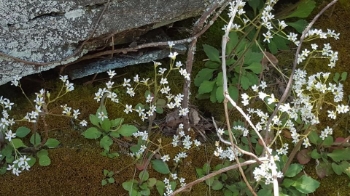

Earth Day Wildflower Walk
Carol Broderson and special guide, Snow Ferreniea enlightened us with their vast knowledge of wildflowers.

Early Spring Wildflowers on the New River Trail
On Easter Saturday, 23 people joined Blue Ridge Discovery Center’s Explorers Club for our annual wildflower walk on the New River Trail. The 57-mile trail is the state’s “most narrow state park,” and the section between Low Water Bridge near Fries and Fries Junction, where a 12-mile spur trail heads to Galax, is a special spot for early spring wildflowers. Hike leader Carol Broderson briefly discussed the history of botanizing in Virginia and the fate of the “great forest” that covered the Appalachians.

Signs of Spring
Spring is a wonderful time of year, with leaves and blooms emerging, birds singing, and amphibian reproduction in full swing. But breeding occurs over a prolonged period since different species have distinct tolerances and adaptations for seasonal progression in temperature and related habitat changes.

Explorers Club Spring Wildflower Walk
Carol Broderson led a group of 17 explorers on an early spring, wildflower walk along the New River Trail last Saturday.